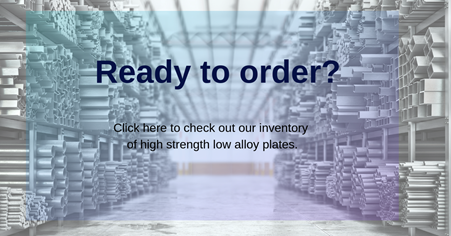
When it comes to high strength low alloy plates (HSLA), it’s not just the strength that is considered higher in comparison to plain carbon steel plates. These plates also feature high ductility, weldability, formability, toughness, and fatigue strength.
HSLA plates have the potential to lower your material costs and increase payloads since the lighter material obtains the strength that is needed. Common applications for HSLA plates include railroad cars, trucks, trailers, cranes, excavating equipment, buildings, and bridges.
When trying to determine which HSLA plate is best for you, ask yourself two simple questions:
1. What are the properties? This is important in the event you need to select an alternative grade.
2. Where is it used?
Ex-Ten 50 or ASTM A572 (50)
Properties: This grade provides high strength, good workability and weldability that is at a comparatively moderate price. The atmospheric corrosion resistance is the same of that of plain carbon steel, and it is available at a strength level of 50 KSI minimum with a tensile strength of 65 KSI. Additionally, this grade conforms to ASTM A572, SAE J1442 Grade 050X.
Where it’s used: Pressure vessels and boiler applications and bridges.
COR-TEN A, COR-TEN B
Properties: This grade is easily cold formed and welded. Cor-Ten A can conform to ASTM A242, and Cor-Ten B can conform to ASTM A588. These grades have a yield point of 50 KSI and a tensile strength of 70 KSI.Where it’s used: With the combination of high strength and outstanding resistance to atmospheric corrosion, it is often used wherever weight reduction or maintenance cost savings are prime considerations. This can include shipping containers, welded bridges, ship building, and tanks.
A656 GR. 80, HI-FORM 80
Properties: This is a low alloy that is hot rolled and controlled cooled steel developed for applications where high strength (80,000 PSI minimum yield) along with toughness, formability, weldability, and fatigue resistance are required. This grade conforms to ASTM A656 Gr. 80 and has a tensile strength of 95 KSI.Where it’s used: Truck frames, crane booms and railroad car components.
Domex 100 XF, Domex 110 XF
Properties: These products are an as-rolled, extra high strength, fine grain, cold forming steel. Low carbon, phosphorus and sulfur levels allow trouble free welding by conventional methods. Domex 100 XF has a yield point at 100 KSI while Domex 110 XF has a yield point at 110 XF. Additionally, Domex 100 XF has a tensile strength of 110 KSI and Domex 110 XF has a tensile strength of 118 KSI.
Where it’s used: Used where high strength and good bendability are needed. Typical applications include cranes, car, truck and rail industries, and agricultural machinery.





.ashx?h=300&w=940&hash=EABCA9416F6FFD1B2F59E336A9EBBC28)
.ashx?h=300&w=940&hash=05F3504B031D57AB25DA1FCA690BC171)